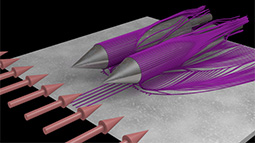Industrial Users
Industrial users of ASCR facilities stimulate innovation, promote U.S. competitiveness, and help maximize the public benefit of ASCR facilities. ASCR facilities are open to industry through the ASCR Facilities access mechanisms. These access mechanisms enable innovation and expand the impact of HPC in industry by providing awardees with computing time and expert assistance in HPC pilot studies, proof-of-concept trials, and validation of simulations at scale. See below for industry success stories from ASCR facilities.
Building on past success and experience with industrial users, ASCR centers continue to promote and facilitate industrial access to ASCR facilities. Industry users of ASCR facilities often have unique requirements from university and national laboratory counterparts, including I.P considerations, proprietary codes, and different user support needs. Additionally ASCR facilities are at the cutting edge of multiple digital technologies and architectures. To help industry navigate the breadth of ASCR capabilities, each facility has established an Industrial User Point of Contact and recommended landing page for industrial users.
Contacts for Industry
OLCF Website for Industry
Suzy Tichenor
Director, Industrial Partnerships,
Computing and Computational Sciences
Oak Ridge National Laboratory
(703) 413-7846
tichenorsp@ornl.gov
NERSC Website for Industry
David Skinner
Strategic Partnerships Lead
NERSC
Lawrence Berkeley National Laboratory
(510) 486-4748
DESkinner@lbl.gov
ALCF Website for Industry
David Martin
Industrial Outreach Lead
Argonne Leadership Computing Facility
Argonne National Laboratory
(603) 252-0929
dem@alcf.anl.gov
ESnet Website for Testbed Access
Brian Tierney
Group Lead
ESnet
Lawrence Berkeley National Laboratory
BLTierney@lbl.gov
Industry Features

GE Researchers Perform Simulations in Pursuit of More Efficient Jet Engines and Wind Turbines
General Electric







